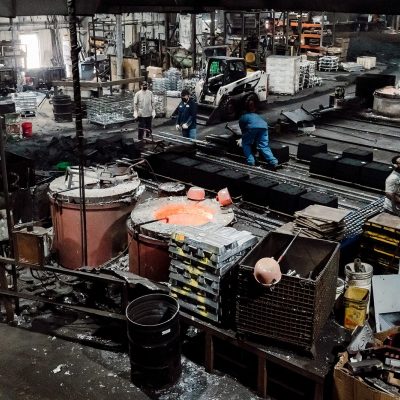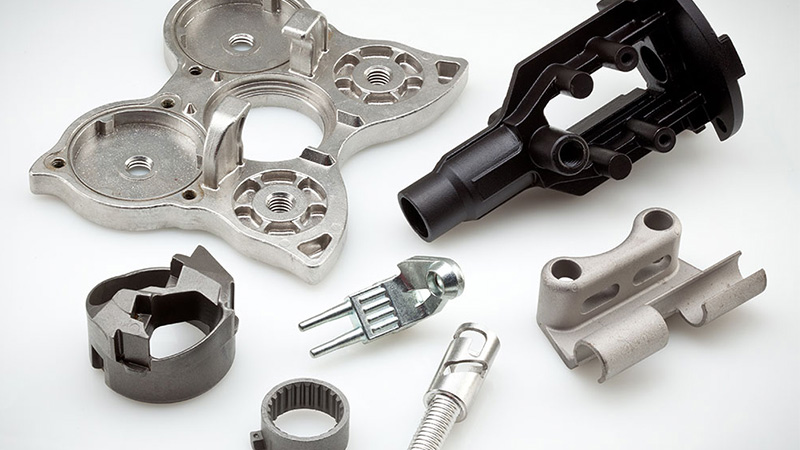Understanding the Metal Castings Refine: A Comprehensive Guide for Beginners
The Metal Casting procedure is a basic strategy in producing that transforms molten steel right into solid kinds. Novices need to grasp the different approaches entailed, such as sand casting and die casting. Recognizing the materials, design concepts, and security measures is just as crucial. Each aspect plays a vital role in accomplishing successful outcomes. As one navigates these intricacies, the inquiry of how to enhance each action for boosted outcomes ends up being progressively pertinent.
The Fundamentals of Metal Casting
Metal Casting has advanced over centuries, its basic concepts continue to be indispensable and constant to the production procedure. At its core, Metal Casting involves the makeover of liquified metal into solid items with various methods. The procedure begins with the production of a mold and mildew, which defines the shape of the last item. Once the mold is prepared, metal is warmed to its melting point and put right into the cavity. After cooling, the steel solidifies, taking the shape of the mold and mildew.
There are numerous casting methods, consisting of sand casting, financial investment spreading, and pass away spreading, each with unique advantages and applications. The choice of technique depends on variables such as manufacturing volume, material kind, and wanted accuracy. As soon as cast, the last product may undertake extra processes like machining or surface treatment to achieve the required coating and specs. Recognizing these essentials is important for anybody interested in the field of Metal Casting.

Comprehending Products Used in Metal Casting
Products play an essential role in the Metal Casting process, affecting the end product's properties and performance. Numerous metals are used, consisting of light weight aluminum, bronze, iron, and steel, each offering distinctive characteristics suited for certain applications. Light weight aluminum is light-weight and corrosion-resistant, making it ideal for automobile parts. Iron, especially cast iron, is preferred for its superb wear resistance and sturdiness. Steel supplies high toughness and convenience, typically used in heavy machinery elements. Bronze, understood for its deterioration resistance and machinability, is commonly used in marine applications.
Along with the steels, numerous casting materials, such as sand, plaster, and ceramic, are utilized to produce mold and mildews. Sand spreading, one of the most widespread approach, makes use of silica sand due to its thermal security and capacity to create elaborate forms. Plaster and ceramic mold and mildews use better details but might call for more complicated processes. The selection of materials straight influences the performance, expense, and top quality of the casting operation.
The Layout Refine: From Idea to Blueprint
The layout procedure in Metal Casting begins with the initial concept growth, where concepts are generated and assessed. This is followed by the application of CAD modeling strategies, enabling for accurate visualizations of the design. Lastly, the plan finalization steps ensure that all specs are precisely recorded for manufacturing.
Initial Principle Development
First idea development notes a vital stage in the Metal Casting process, where ideas change into substantial styles. During this stage, designers collaborate with designers and stakeholders to brainstorm and improve preliminary concepts. They consider variables such as performance, visual appeals, and manufacturability, making certain that the design fulfills the required specs and efficiency standards. Illustrations and rough drafts are developed to imagine the principles, allowing for initial analyses of usefulness and cost-effectiveness. This phase likewise involves recognizing materials and possible spreading methods that straighten with the layout objectives. Ultimately, initial idea advancement prepares for a detailed blueprint, directing the subsequent stages of the casting procedure and making certain a successful shift from principle to truth.
CAD Modeling Techniques
Changing principles right into specific designs, CAD modeling methods play a pivotal function in the Metal Casting procedure. These methods make use of sophisticated software application to develop comprehensive three-dimensional models that properly show the desired item. By using tools such as parametric modeling, strong modeling, and surface modeling, developers can adjust measurements and shapes effortlessly. CAD systems additionally assist in simulation and evaluation, enabling the identification of potential problems prior to manufacturing starts. This aggressive technique minimizes product waste and maximizes the layout for manufacturability. In addition, CAD models can be quickly modified, allowing quick iterations based on responses. Basically, CAD modeling functions as the backbone of the style procedure, connecting the gap between initial ideas and the eventual production-ready designs.
Plan Finalization Steps
Following the production of detailed CAD versions, the following phase involves plan completion, which is critical in equating electronic designs into workable plans for production. This process begins with examining the CAD models for accuracy and conformity with specifications. When verified, the measurements, tolerances, and material requirements are thoroughly outlined to assure clarity. Incorporating annotations and notes aids interact important details relating to spreading processes, surface area finishes, and setting up requirements. The completed plan goes through an extensive approval procedure, frequently including partnership with engineers and manufacturing groups to attend to any potential concerns. Besides alterations are made and authorizations gotten, the plan is officially released, functioning as the fundamental file for the succeeding stages of Metal Casting, including pattern making and mold layout.
The Steel Casting Methods Explained

Metal Casting techniques encompass a range of techniques used to form molten metal right into desired forms. These techniques differ according to the kind of product, complexity of the style, and manufacturing quantity. Sand casting is just one of one of the most common approaches, including the creation of a mold from sand to basics hold the molten steel. Investment spreading, or lost-wax casting, permits intricate layouts by utilizing a wax pattern that is dissolved. Die casting uses high-pressure shot of molten steel right into a mold, suitable for automation. Various other approaches include permanent mold spreading, which uses recyclable mold and mildews, and centrifugal spreading, where rotational pressures assist in filling the mold and mildew. Each technique has its benefits and applications, making it crucial for makers to select the ideal approach based upon their particular demands and requirements. Recognizing these methods is important for any individual associated with the Metal Casting process.
Finishing Procedures: Enhancing Your Casted Product

Finishing processes play an important function in enhancing the high quality and look of casted items. Numerous surface treatment methods, such as polishing and coating, are employed to enhance sturdiness and aesthetic appeals. Additionally, high quality assessment methods assure that the final product meets specified requirements and efficiency needs.
Surface Therapy Strategies
A range of surface therapy methods play an essential function in enhancing the high quality and longevity of casted products. These strategies include techniques such as shot blasting, brightening, and layer. Shot blasting effectively eliminates surface area imperfections, enhancing the useful and aesthetic attributes of the spreading. Polishing gives a smooth finish, which is especially vital for decorative applications and elements requiring very little friction. Coating methods, such as electroplating or powder covering, deal added security against corrosion and wear, ensuring longevity. Surface area treatments can boost adhesion for subsequent processes, such as painting or bonding. By employing these approaches, makers can achieve exceptional surface quality, which is critical for the performance and life-span of Metal Casting in various applications.
High Quality Examination Approaches
Effective high quality assessment approaches are vital for guaranteeing the stability and performance of casted items after the finishing processes. Numerous strategies are utilized to evaluate the top quality of Metal Casting, consisting of aesthetic evaluation, dimensional checks, and non-destructive screening (NDT) Visual examination enables the identification of surface area defects, while dimensional checks ensure that products fulfill specified tolerances. NDT techniques, such as ultrasonic testing and radiographic evaluation, provide much deeper understandings right into internal integrity without harming the castings. Additionally, mechanical screening, such as tensile and firmness tests, evaluates product properties - Metal Castings. By using a mix of these approaches, manufacturers can boost item high quality and reliability, inevitably causing greater client fulfillment and lowered production costs
Security Considerations in Metal Casting
While the Metal Casting process uses numerous advantages, it likewise provides a range of security threats that must be carefully handled. Employees in casting these details facilities are revealed to high temperatures, molten metals, and hazardous materials, which can bring about serious injuries if appropriate safety measures are not taken. Personal protective tools (PPE) such as heat-resistant gloves, deal with guards, and protective garments is crucial to decrease threats.
Furthermore, the existence of fumes and dust demands appropriate ventilation systems to guarantee air quality - Aluminum Castings. Routine training on safety protocols is essential for all employees to acknowledge prospective threats and react successfully. Emergency treatments must be established, consisting of fire precaution and emergency treatment accessibility. Upkeep of devices and correct handling of materials even more add to a safer working environment. By prioritizing these security factors to consider, Metal Casting procedures can shield their labor force and keep reliable production processes
Often Asked Concerns
What Are the Environmental Impacts of Metal Casting?
Metal Casting can lead to environmental effects such as air and water pollution, source deficiency, and power intake. In addition, inappropriate waste monitoring and exhausts from factories add to ecological disruptions and health dangers for nearby areas.
Just how Do I Select the Right Steel for Casting?
To pick the appropriate metal for spreading, one should take into consideration variables such as mechanical residential or commercial properties, rust resistance, thermal conductivity, and price. Reviewing the desired application and ecological problems is vital for excellent choice.
What Are the Common Issues in Metal Casting?
Usual problems in Metal Casting consist of porosity, shrinkage, sand addition, and misruns. These concerns frequently develop from incorrect product selection, insufficient style, or imperfections in the casting process, affecting the end product's high quality and efficiency.
Just How Can I Improve My Steel Casting Skills?
To enhance Metal Casting skills, one must exercise continually, study casting techniques, evaluate previous jobs for flaws, seek feedback from skilled wheels, and continuously trying out various materials and methods to improve efficiency and understanding.
What Is the Expense of Beginning a Metal Casting Organization?
Starting a steel casting service normally calls for a first financial investment of $5,000 to $50,000, relying on tools, products, and facility costs. Aspects like place and scale can considerably influence total start-up costs.
The Metal Casting procedure is an essential strategy in producing that transforms molten metal into strong types. Novices need to comprehend the different techniques included, such as sand casting and pass away casting. There are several check that casting methods, including sand casting, financial investment spreading, and die spreading, each with special advantages and applications. Investment spreading, or lost-wax casting, allows for complex styles by using a wax pattern that is thawed away. Other methods include irreversible mold and mildew casting, which makes use of multiple-use mold and mildews, and centrifugal casting, where rotational pressures aid in loading the mold.